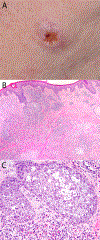Follicular mucinosis in patients with hematologic malignancies other than mycosis fungoides: A clinicopathologic study
- PMID: 30716405
- PMCID: PMC6526060
- DOI: 10.1016/j.jaad.2019.01.062
Follicular mucinosis in patients with hematologic malignancies other than mycosis fungoides: A clinicopathologic study
Abstract
Background: Follicular mucinosis (FM), which is defined by mucin accumulation within follicular epithelium, may occur in mycosis fungoides (MF). FM without MF is occasionally reported in systemic hematologic malignancies and may be diagnostically challenging.
Objective: To describe clinicopathologic characteristics of FM in patients with hematologic malignancies other than MF.
Methods: Clinical data and histopathology features were analyzed in patients with FM and hematologic malignancies diagnosed between 1994 and 2017.
Results: A total of 18 patients with FM and systemic hematologic malignancies without cutaneous T-cell lymphoma (CTCL) were identified; 9 of them were discovered after hematopoietic stem cell transplantation. No patients with non-CTCL-associated FM (n = 46 [37 biopsy specimens]) developed CTCL during a mean follow-up of 4.3 years. Of the cases of CTCL associated with FM (n = 44 [31 biopsy specimens]), MF was the most common subtype (n = 38), although other CTCLs were identified. FM in patients with non-CTCL hematologic malignancies differed clinically from those with MF-associated FM, presenting most frequently with erythematous papules (P < .0001), without plaques (P <.0001), without alopecia (P = .001), and without histopathologically identified epidermal exocytosis (P = .013).
Limitations: A retrospective study in a single cancer center.
Conclusions: FM can present in systemic hematologic malignancies, including after hematopoietic stem cell transplantation. Papular lesional morphologic and histopathologic features may help to distinguish these cases from MF.
Keywords: CD30(+) lymphoproliferative disorders; CTCL; MF; cutaneous T-cell lymphoma; follicular mucinosis; hematopoietic stem cell transplantation; histopathology; mycosis fungoides.
Copyright © 2019 American Academy of Dermatology, Inc. Published by Elsevier Inc. All rights reserved.
Conflict of interest statement
Figures


Comment in
-
Predicting the nature of follicular mucinosis: Still a sticky situation.J Am Acad Dermatol. 2019 Jun;80(6):1524-1525. doi: 10.1016/j.jaad.2019.04.005. Epub 2019 Apr 5. J Am Acad Dermatol. 2019. PMID: 30959090 No abstract available.
-
T-cell prolymphocytic leukemia with follicular mucinosis.Int J Dermatol. 2023 Mar;62(3):e151-e153. doi: 10.1111/ijd.16347. Epub 2022 Jul 3. Int J Dermatol. 2023. PMID: 35781251 No abstract available.
References
-
- Mir-Bonafe JM, Canueto J, Fernandez-Lopez E et al. Follicular mucinosis associated with nonlymphoid skin conditions. Am J Dermatopathol 2014; 36: 705–9. - PubMed
-
- Willemze R, Jaffe ES, Burg G et al. WHO-EORTC classification for cutaneous lymphomas. Blood 2005; 105: 3768–85. - PubMed
-
- Cerroni L, Fink-Puches R, Back B et al. Follicular mucinosis: a critical reappraisal of clinicopathologic features and association with mycosis fungoides and Sezary syndrome. Arch Dermatol 2002; 138: 182–9. - PubMed
-
- Boer A, Guo Y, Ackerman AB. Alopecia mucinosa is mycosis fungoides. Am J Dermatopathol 2004; 26: 33–52. - PubMed
-
- Brown HA, Gibson LE, Pujol RM et al. Primary follicular mucinosis: long-term follow-up of patients younger than 40 years with and without clonal T-cell receptor gene rearrangement. J Am Acad Dermatol 2002; 47: 856–62. - PubMed
Publication types
MeSH terms
Grants and funding
LinkOut - more resources
Full Text Sources

